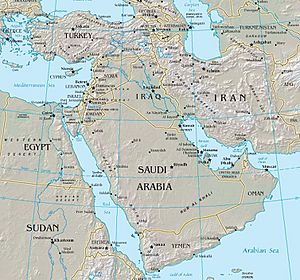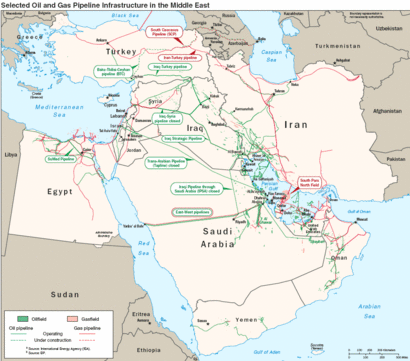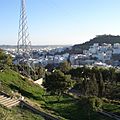Middle East facts for kids
The Middle East is a big region that includes countries in Southwest Asia and North Africa. People often call these countries "Middle Eastern" because they are near the eastern Mediterranean or west of Central Asia.
Here are some of the main countries usually considered part of the Middle East:
Sometimes, other nearby countries are also included, like Algeria, Morocco, and Tunisia in North Africa. Countries like Pakistan, Afghanistan, and several "stan" countries in South-Central Asia (like Kazakhstan and Uzbekistan) are sometimes added too.
This region is where some of the world's first civilizations began. Places like Sumer, Babylonia, and Ancient Egypt grew in an area called the Fertile Crescent. The three main religions that believe in one God – Judaism, Christianity, and Islam – also started here.
Today, the Middle East is very important because a lot of the world's petroleum (oil) comes from this area. It is also a region where there have been many disagreements and conflicts, such as the Israeli-Palestinian conflict and the Syrian civil war.
Contents
People and Cultures
Different Groups of People
The Middle East is home to many different groups of people. The largest group is the Arabs. Other major groups include Turkic people and Persians.
Many other native groups also live in the region. These include Arameans, Assyrians, Baloch, Berbers, Copts, Druze, Jews, Kurds, Lurs, Mandaeans, Samaritans, Shabaks, Tats, and Zazas.
Why People Move
People have always moved around in the Middle East for different reasons. From the 1970s to the 1990s, many workers from countries like Egypt and Yemen moved to the rich Persian Gulf states to find jobs. Young people from North Africa often moved to Europe because it was close and due to historical ties.
Today, many people still move within the Middle East or to other parts of the world. Some move to find better jobs or to send money back home to their families. Others move because they are part of a minority group facing challenges in their home country. For example, many Kurds, Jews, Assyrians, Greeks, and Armenians have left countries like Iraq, Iran, Syria, and Turkey over the last century.
Religions of the Region
The Middle East is a very diverse place when it comes to religions. Many of the world's major faiths started here. Islam is the largest religion in the Middle East. However, Judaism and Christianity, which also began in this region, are still widely practiced.
In Lebanon, for example, about 40.5% of the people are Christians. Other important minority religions include the Bahá'í Faith, Yarsanism, Yazidism, Zoroastrianism, Mandaeism, Druze, and Shabakism. Long ago, the region was also home to many ancient religions.
Languages Spoken
The most spoken languages in the Middle East are Arabic, Persian, Turkish, Kurdish, and Hebrew.
- Arabic is the most widely spoken language. It is the official language in most countries in North Africa and West Asia.
- Persian is the second most spoken language. It is mainly spoken in Iran, which is one of the region's largest countries.
- Turkish is the third most spoken language. It is mostly spoken in Turkey, another large and populated country in the region.
- Hebrew is one of the two official languages of Israel, along with Arabic.
- English is often taught and used as a second language, especially in business and among educated people in countries like Egypt, Jordan, and the United Arab Emirates.
- French is used in some parts of Lebanon, and taught in schools in Egypt and Syria.
- Other languages like Armenian, Greek, Georgian, and Russian are also spoken by different communities.
- Languages like Bengali, Hindi, and Urdu are widely spoken by migrant workers from South Asia in countries like Saudi Arabia and the United Arab Emirates.
How the Economy Works
The economies of Middle Eastern countries are quite varied. Some countries, like Saudi Arabia, the UAE, and Kuwait, depend a lot on selling oil and oil-related products. Others, like Cyprus, Israel, Turkey, and Egypt, have more diverse economies.
Important industries in the Middle East include:
- Oil and gas production
- Agriculture (farming)
- Making textiles and leather products
- Creating surgical instruments and defense equipment (like guns and tanks)
- Banking, which is very important in places like the UAE and Bahrain.
Tourism has been growing in recent years. Countries like the UAE, Bahrain, and Jordan are attracting more visitors as they improve their tourist facilities.
Related pages
Gallery
-
Abu Dhabi - UAE
-
Amman - Jordan
-
Ankara - Turkey
-
Baghdad - Iraq
-
Beirut - Lebanon
-
Cairo - Egypt
-
Damascus - Syria
-
Doha - Qatar
-
Dubai - UAE
-
Istanbul - Turkey
-
Jerusalem - Israel
-
Kuwait City - Kuwait
-
Manama - Bahrain
-
Mecca - Saudi Arabia
-
Muscat, Oman
-
Nicosia , Cyprus
-
Ramallah - Palestine
-
Sana'a - Yemen
-
Tabriz - Iran
-
Tehran - Iran
-
Tel Aviv - Israel
Images for kids
-
Some henges at Göbekli Tepe were built around 9600 BC, making them older than Stonehenge. It is the site of the oldest known man-made religious structure.
-
Church of the Holy Sepulchre in Jerusalem
-
The Kaaba, located in Mecca, Saudi Arabia
-
Abu Dhabi – United Arab Emirates
-
Amman – Jordan
-
Ankara – Turkey
-
Beirut – Lebanon
-
Cairo – Egypt
-
Damascus – Syria
-
Doha – Qatar
-
Dubai – United Arab Emirates
-
Istanbul – Turkey
-
Jerusalem – Israel
-
Manama – Bahrain
-
Muscat – Oman
-
Ramallah – Palestine
-
Sana'a – Yemen
-
Tehran – Iran
-
Tel Aviv – Israel
See also
 In Spanish: Oriente Medio para niños
In Spanish: Oriente Medio para niños
















































